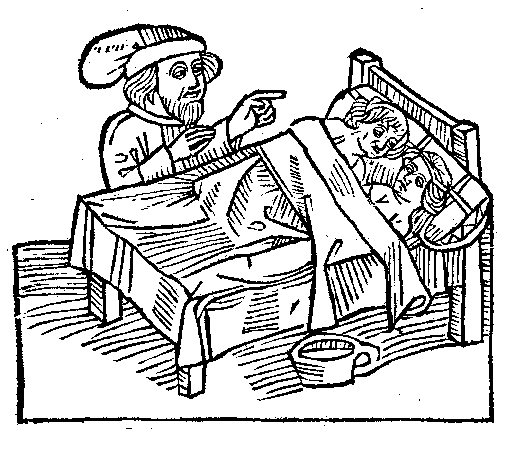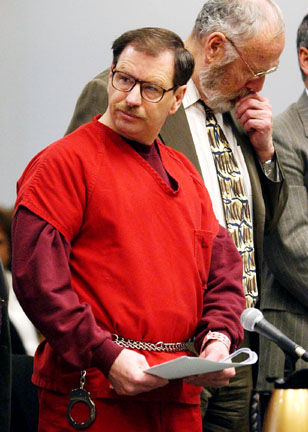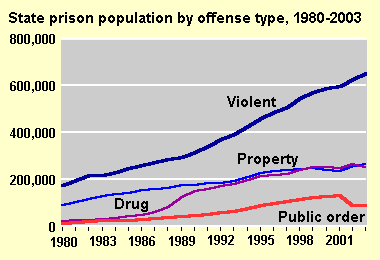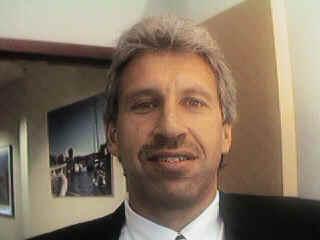Home » Literature Archives » Early Release From Prison: A Bad Idea
EARLY RELEASE FROM PRISON: A BAD IDEA
by Ming Zhen Shakya
- Robert Frost
"Sticks and stones may break my bones, but names will never hurt me." It's a quaint old quip that more and more describes the way we categorize crime. It comes in tandem with that other maxim that illuminates the quality of justice we may all expect: "The Golden Rule states that they who have the gold make the rules."
As if we're all afflicted with haphephobia - the fear of being touched - we make peculiar distinctions about violence and non-violence. One man may appropriate the identities of a hundred men and use that information to steal their homes, their assets, and their good names - without committing a single act of violence. But if, as those men pace back and forth, biting their knuckles in despair, one of them so much as shoves that man aside in a show of contempt; ah... that man has committed a violent crime.
This division of crime into violent and non-violent has ingrained social implications. Ever since human beings established differences between those who "have" and those who "have not" - regardless of the nature of that which is possessed, be it power, wealth, beauty, and so on - those who have the vaunted commodity seem also to have immunity for their crimes, if not from prosecution, then at least from punishment. Particularly when the class distinction is economic, justice systems - dazzled into benediction by the aura of gold - tend to 'hold harmless' the wealthy and powerful.
It was in feudal times that this perception of an intrinsic difference between refined aristocrats and coarse peasants first informed our definitions of violent crimes (those which involve touching one's person) and non-violent crimes (those which don't). Although rich and poor could certainly commit the same type of crime, different standards applied. Brutish peasants needed rigorously to be controlled lest they raise a hand against their masters. (Even today, without an expressed invitation, protocol prohibits touching royal persons just as bodyguards prevent touching their client.) When nobles killed it was usually considered statecraft or sport. Jurisprudence had its positive side: nothing could keep a noble more fit or more discreet than Trial By Combat, a frequent method of determining the winner's innocence.
 Picture of ritual defloration in the travel book of Mandeville, ed. 1484, book 4, chapter 7, fol. 8v.
Picture of ritual defloration in the travel book of Mandeville, ed. 1484, book 4, chapter 7, fol. 8v.
How ingrained this sense of inferiority was can be seen in the strange fact that what was violent and punishable when committed by peasants was often the benign privilege of aristocracy. Rape, amongst peasants, was a crime; but the act had a different character when nobility was involved. Under the law of Jus primae noctis or Droit du seigneur, feudal lords had the right to deflower a peasant's bride. Whether she liked it or not, the bride's wedding night was spent with the lord of the manor, not with her husband. And while a nobleman could hardly be charged with raping a peasant, a peasant's raping of a noblewoman - if he were sufficiently demented to attempt it - would be met with an unpleasant execution.
In ways gross or subtle, property crimes revealed the strange distinctions in class justice. Illiterate peasants did not own property, they were property. They could pilfer, filch, snatch, pinch or swipe from each other; but, as the verbs suggest, these were trifling crimes, adjudicated by priests or constables. For violent crimes - such as taking the nobles' property by killing a deer or another peasant, nobles could preside at the trial.
But only the literate aristocracy could commit serious property crimes in which written instruments determined ownership: larceny, fraud, embezzlement, forgery; and only nobles could judge each other. It was unthinkable that the common man could ever sit in judgment of the aristocracy; and not even centuries of legislative equality and the power to sit on a jury of his "peers" has ever dispelled the notion that somehow the ordinary man is not quite qualified to judge his economic superiors.
 AP PHOTO Gary Ridgway, left, listens as individual guilty pleas are read in the King County Courthouse in Seattle.
AP PHOTO Gary Ridgway, left, listens as individual guilty pleas are read in the King County Courthouse in Seattle.
And it is still unfortunately true that the seriousness of a crime depends more on the status of the persons involved than it does with the act, itself. When a society deems certain people intrinsically inferior and crimes are committed against them, reason's will to rectify the injustice has to grapple with that ingrained sense of holding harmless the superior person, i.e., the one who did the harming. (When the KKK murdered black citizens fifty years ago, it took the Justice Department more than a generation to hold anyone responsible. Old KKK defendants needed walkers and oxygen to make it into court. When 50 prostitutes were killed and dumped into the Green River in Washington State over a period of nearly 20 years, it took the police that long to charge Gary Ridgway with the crime - and then they let him plea bargain his way out of the death penalty.)
While the various justice systems show no reluctance to punish the poor, they all seem to retain that innate renitence to discomfit the rich. In a landscape filled with video cameras to catch a furtive shoplifter, the magnitude and the duration of corporate criminal activity and the brazenness with which fraudulently obtained money is squandered - for example, a $2 million birthday party given by a CEO for his wife; all attest to this peculiar double standard. Our various regulatory agencies are more blind than Justice aspires to be. Anyone who doubts this should consider Worldcom; Enron; Adelphia; Quest; Tyco; the list is endless. Perhaps the best example of the judicial generosity shown to a rich person whose "errors" caused him the inconvenience of arrest is the case of Charles Keating of the great Saving and Loan debacle.
In 1980, Keating's American Continental Corporation (ACC), a real estate investment company, began to invest in Phoenix, Arizona's booming real estate market. At this time, the savings and loan institutions were in deep financial trouble. In the Carter administration, the Fed, in a move to stem inflation, had drastically raised interest rates; and the S & Ls, unable by law to increase the low rate of interest they paid on deposits, faced bankruptcy as their customers withdraw their accounts to place them in banks in which they'd earn three times as much in interest. The S & Ls had lent out their depositors' money on low interest 30 year mortgages. Now, as the depositors withdrew funds, the S & Ls were unable to meet the withdrawal requests without borrowing money. By law, also, they were narrowly limited to the kinds of loans they could make, a restraint which hampered their ability to compete in more lucrative markets. S & L assets quickly slipped away as they approached the critical point at which the federal government was obliged to declare them insolvent and to liquidate their remaining assets.
In order to avert a financial disaster, Congress moved to deregulate the Savings and Loans so that they could compete with ordinary banks by being able to increase the interest they paid to their depositors; issue credit cards; borrow from the Fed; lend money to a variety of projects and to participate as owners in those projects. To make deposits with the S & Ls more attractive, they increased the deposits they insured from $40,000 to $100,000.
In 1984, Keating's ACC purchased California's Lincoln Savings and Loan and its 30 branches. The price was $55 million which Keating paid using $51 million in junk bonds engineered by Michael Milken.
Lincoln's life's blood was $1 billion in assets; and ACC was in desperate need of a transfusion. Keating moved Lincoln's main office to Phoenix, installed his cronies in administrative positions, and proceeded to bleed Lincoln dry.
 Estrella Mountain Ranch Estates
Estrella Mountain Ranch EstatesPhoto Credit:
Using Lincoln's money, ACC purchased 20,000 acres of land southwest of Phoenix for an average $3.000. an acre ($60 million). The plan was to develop the land, now called Estrella Mountain Ranch, until, by the year 2000 it would contain 50,000 custom homes, the individual lots of which would be worth an exponentially greater sum than they original cost. By 1987 Lincoln had invested $100 million dollars in the development. ACC was building office buildings and hotels - including the grandiose $300 million Phoenician Hotel that had everything but guests. On the surface, Keating appeared to epitomize the American Tycoon: private jet, helicopter, the works.
As the government would later charge, ACC's success was a grand illusion. ACC sold parcels of Estrella land at extremely inflated prices to "straw buyers" who borrowed money from Lincoln to pay ACC for the land that Lincoln had furnished ACC with the money to buy. ACC made $82 million in "profit" which enabled Keating and his associates to receive huge salaries and bonuses and to make productive contributions to the campaigns of five U.S. Senators.
Keating now offered his admirers the opportunity to buy $250 million of ACC bonds. Naturally, he could not have the bonds underwritten - that would mean that ACC would have to be audited. Keating quietly skipped that nicety, and the undesirable bonds were marketed by the only financial institution that would touch them - his own Lincoln S & L. Misled by salesmen into believing that the bonds were federally insured, 23,000 ordinary folks, many who trusted Keating with their life savings, bought the $250 million load of fancy paper. Worse, the bonds were subordinated debentures and could be paid off only after ACC paid off its other debts.
In 1989 ACC suddenly declared bankruptcy and within twenty-four hours federal agents seized control of Lincoln S & L, The numbers added up to $3.2 billion, the costliest S & L failure in U.S. history. American taxpayers had to cough up $2 billion to cover Lincoln's insured losses. If Keating's business practices were not sleazy enough - and they certainly ought to have been - days before he declared bankruptcy, he looted ACC of its final million dollars.
Keating was charged in both federal and state (California) court with fraud, racketeering, and conspiracy. Called to testify before the Senate Banking Committee, he took the 5th.
 Keating and Mother Teresa
Keating and Mother Teresa
Lance Ito presided over Keating's California trial with the same degree of incompetence he displayed when he presided over the O.J. Simpson trial. Keating, a practicing Catholic, had donated $1.25 million to Mother Teresa in India in time for her to oblige him by writing a personal letter to Judge Ito telling him what a good man Keating was. Despite this saintly testament, Keating was convicted of all charges and sentenced to ten years in prison; but the appellate court overturned his conviction because Judge Ito had somehow forgotten to instruct the jury that "intent" mattered.
Keating was also convicted in federal court, receiving a sentence of twelve years. But this conviction, too, miraculously was overturned on grounds that it was possible that some of the federal jurors had been influenced by the decision of the California jurors.
He was granted a new federal trial; but he avoided that by reaching a plea agreement: he admitted to bankruptcy fraud committed when he looted ACC of that final million, and the federal prosecutors dropped all charges against him and his family. He was sentenced to time served - the four years he had been in jail pending his appeals.
A federal class action suit filed by those he had defrauded resulted in a $3.3 billion dollar judgment against him. It was later reduced to $1.6 billion (mere peanuts to the bankrupt).
The Securities and Exchange Commission filed and won its case against Keating which was settled in 1994 when Keating, already bankrupt, promised to repay millions of dollars if he ever found enough money.
The government's Resolution Trust Corporation that officially took over Lincoln when it was declared insolvent filed another case against Keating. The result in 1994 was a summary judgment of $4.3 billion against Keating and his wife. In 1999, the decision was overturned on appeal.
The U.S. Supreme Court was asked to rule on the Appellate Court's decision to overturn Keating's conviction in Lance Ito's court. They refused to hear the appeal in October 2000. State prosecutors declined to request a new trial.
The rippling effect of this catastrophic non-violent crime brought suffering to so many decent citizens. If Keating had mugged only one of them, he would likely have served more time. It is safe to say that despite the frailty of many of the elderly, if they were asked to choose either the physical pain of being the victim of assault and battery or the anguish and hardship caused by the loss of their savings, there would be blood on the streets but no regrets about it.
And now we have another opportunity for conscience to compromise itself. States, confronted with the problem of overcrowded prisons, have chosen to solve the problem by reducing prison populations! Even before "non-violent" inmates are eligible to apply for parole, they are being released. To bureaucrats and swindlers this must sound like a splendid idea. Many of us are shaking our heads in disbelief.
 Correctional Populations in the United States, Annual and
Prisoners in 2005.
Correctional Populations in the United States, Annual and
Prisoners in 2005.
Which crimes are considered violent and which are not? Here is a selection from the U.S. Department of Justice's September 6, 2006 list (http://www.ojp.usdoj.gov/bjs):
Violent offenses include the usual "touching" crimes of murder, manslaughter, rape, sexual assault, assault, intimidation, criminal endangerment, and so on.
Crimes that are serious but not categorized as violent are property offenses such as burglary, larceny, car theft, fraud, possession and selling of stolen property, destruction of property, trespassing, vandalism, criminal tampering, and so on. Drug offenses include possessing, making, and trafficking. Public-order offenses include drunk driving, and a variety of vice crimes.
Such crimes as identity and credit card theft; embezzlement; forgery; corporation racketeering, "confidence" scams, internet deceptions, and all manner of financial misrepresentations are considered non-violent. After the public has paid by being victimized by these criminals, and then for their apprehension and trial, state legislators are now saving money by setting them free. And it is public safety, we are told, that is the primary consideration in the early release program.
White collar crime is already shamefully under-punished. That the states would prefer to release people who belong in prison when there are so many drug addicts and mentally ill inmates who do not - makes little or no sense.
In September 2006, the Department of Justice released the results of a long study of inmate populations (http://www.ojp.usdoj.gov/bjs/pub/press/mhppjipr.htm). More than half reported suffering depression, mania, hallucinations, and other psychotic disorders. Half of these inmates had committed a current or past violent offense. Many had served three or more sentences prior to their present incarceration, a rate of recidivism which demonstrated the revolving-door nature of this category of offender.
All too often a mentally ill or addicted person becomes increasingly violent as his life spins out of control. He loses his job, his family, his home. Life of the streets is a prelude to incarceration.
Many addicts who commit crimes got started on that path not from taking recreational drugs, but from legally prescribed pain medications. When their legal supply was terminated, they sought expensive illegal drugs. Paying for them was the motive for their crimes.
Before the pharmaceutical industry rouged our vision, we could tell the difference between criminal and insane. We had prisons and asylums. But when post WWII research found effective ways to treat mental illness with psychotropic medications, we tore down the isolated asylums, moved the incurable patients into new hospitals, and sent the rest home. The plan was that they'd be treated as outpatients in small, localized mental health clinics, and so we welcomed the golden age of "walk-in" consultations and pill-controlled sanity. The clinics never got past the idea phase; but the drugs multiplied like tribbles on quadro-triticale.
For the next fifty years we fought wars: Korea, Viet Nam, Poverty. For the mentally ill, for the stressed-out veterans, and for the hundreds of thousands of fatherless and too-often malnourished and neglected kids who were the drug-vulnerable refugees of the War on Poverty, prisons substituted for hospitals. It made no difference if a person committed a crime because he needed to satisfy a heroin addiction or because his dog told him to do it. He went to jail and shared quarters with real criminals who were eager to exploit his vulnerability.
Nobody was rehabilitated. Three-fourths of the inmate population who were released returned to the life of crime that got them convicted in the first place. The increasing number of drug addicts brought increasing number of crimes' but citizens did not care to fund the construction of new prisons any more than they had wanted to build all those cozy clinics. Crime, punishment, and "pentimento" had reached an existential critical mass.
There were moments of enlightenment. In 1989, Miami Florida's Judge Herbert Klein separated non-violent drug and alcohol addicts from the rest of criminal defendants. He founded the nation's first non-adversarial drug court which has since become the model for 1700 drug courts throughout the country. These courts provide for treatment, rehabilitation, and frequent test monitoring of the participants, including juveniles.
 The Honorable Judge Mark Speiser, Broward County Florida Circuit Court Judge
The Honorable Judge Mark Speiser, Broward County Florida Circuit Court Judge
In 1998, Broward County, Florida's Judge Mark Speiser created a Mental Health Court. Defendants charged with non-violent crimes were diverted to this specialty court to be evaluated and treated in a mental health facility. Cottages on hospital land provided shelter for the homeless as they underwent treatment. Clearly, if these patients could be helped at a non-violent stage, more serious crimes would be prevented. The Mental Health Court of Broward County immediately became a national model.
Jails rarely conduce to the betterment of mental illness. A combat veteran with psychological problems cannot always travel to a VA hospital; and once he has lost control and committed a crime, he is not likely to be helped in any prison setting. A young mother with post-partum depression cannot simply leave her baby to enter a sanatorium; and once her depression gravitates into psychosis and she becomes harmfully delusional, she, too, is not likely to be helped in any prison setting. Early attention obviates the need for more drastic interventions at a later time - as the existing specialty courts and treatment centers have demonstrated.
The question is, why aren't these two specialized court systems being embraced more vigorously by the states? The statistics are in: wherever there is a court-treatment facility available for these patients, the community has received a great return on its investment. There are fewer homeless, fewer crimes, and fewer inmates. And it is the civilized way to respond to the plight of these individuals. And, needless to say, in a society that prides itself on free enterprise and the entrepreneurial spirit, those individuals in power who profit from deliberate corporate mismanagement ought to be held to a higher standard of integrity or, more realistically, to any standard, since apparently they have been operating in an enjoyable and rather lucrative ethical dearth.
Buddhists are supposed to speak with authority on the subject of non-violence, but other than the folks who oppose the death penalty, on the subject of crime and punishment, we don't seem to be bringing much to the table. We do, however, know enough about harmlessness to know that non-violent doesn't necessarily mean harmless.
Ahimsa, the avoidance of violence, does not give non-violence a blanket endorsement. Avoiding violence requires us to alleviate those conditions which engender violence. Too many Buddhists believe that if we eliminate an instrument of violence, we eliminate violence. This underestimates the ingenuity of evil intentions. What needs to be eliminated is the desire to harm; and this is where we should direct our efforts. We can begin by offering help at the onset of the distress, long before an afflicted person spirals down into a state of irreparable destruction. Local mental health and drug-alcohol treatment facilities and specialized non-adversarial courts to deal with the crimes these patients have committed are the proven way to alleviate prison overcrowding. The defendants can be treated as outpatients if the condition permits, or as inpatients - voluntary or Involuntary - when the condition requires it. Nobody is advocating coddling serial killers. But there is a moment in time when what is salvageable passes into being beyond restoration, and we need seize the opportunity to salvage before that time expires.
The case of Charles Keating is unusual only because of the huge amount of money he cost the taxpayer. At any amount of money, criminals of this ilk belong in prison.. Releasing them because in their felonious activities they got rich and also managed to avoid manhandling anyone takes us back to the Dark Ages.
But worst of all, the poor have the additional burden of knowing that Justice, far from being blind, carefully separates the rich, the powerful, the celebrated - and applies to them a different and far more lenient standard.

